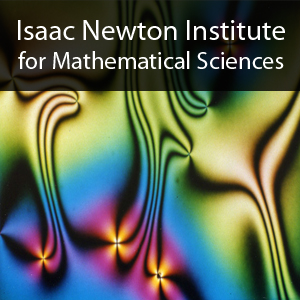Rigidity, Zero Modes, States of Self Stress, and Surface Phonons in Periodic and Diluted Periodic Networks near their Instability Limit
Duration: 1 hour 11 mins
Share this media item:
Embed this media item:
Embed this media item:
About this item

| Description: |
Rothschild Visiting Professor Tom Lubensky (University of Pennsylvania)
Monday 24 June 2013, 16:00-17:00 |
|---|
| Created: | 2013-06-25 11:21 |
|---|---|
| Collection: |
The Mathematics of Liquid Crystals
Rothschild Seminars |
| Publisher: | Isaac Newton Institute |
| Copyright: | Tom Lubensky |
| Language: | eng (English) |
| Abstract: | Frames consisting of nodes connected pairwise by rigid rods or central-force springs, possibly with preferred relative angles controlled by bending forces, are useful models for systems as diverse as architectural structures, crystalline and amorphous solids, sphere packings and granular matter, networks of semi-flexible polymers, and protein structure. The rigidity of these networks depends on the average coordination number z of the nodes: If z is small enough, the frames have internal zero-frequency modes, and they are "floppy"; if z is large enough, they have no internal zero modes and they are rigid. The critical point separating these two regimes occurs at a rigidity threshold, which corresponds closely to what is often referred to as the isostatic point, that for central forces in d-dimensions occurs at coordination number zc = 2d. At and near the rigidity threshold, elastic frames exhibit unique and interesting properties, including extreme sensitivity to boundary conditions, power-law scaling of elastic moduli with (z- zc), and diverging length and time scales.
This talk will explore elastic and mechanical properties and mode structures of model periodic and diluted periodic lattices, such as the square and kagome lattices with central-force springs, that are just on verge of mechanical instability, and 4-coordinated lattices in two and three dimensions that are stabilized by bending forces. It will discuss the origin and nature of zero modes of these structures under both periodic (PBC) and free boundary conditions (FBC), and it will derive general conditions under which (a) the zero modes under the two boundary conditions are essentially identical and (b) under which zero modes do not appear in the periodic spectrum but do appear as surface Rayleigh waves in the free spectrum. In the former situation, lattices are generally in a type of critical state that admits states of self-stress in which there can be tension in bars with zero force on any node, and distortions away from that state give rise to surface modes under free boundary conditions whose degree of penetration into the bulk diverges at the critical state. This general phenomenon also occurs in sub-isostatic lattices like the honeycomb lattice. The talk will also explore diluted 4-coordinated lattices as models for networks of semi-flexible polymers, discuss the special properties that result when constituent polymers adopt strictly straight configurations. |
|---|---|
Available Formats
| Format | Quality | Bitrate | Size | |||
|---|---|---|---|---|---|---|
| MPEG-4 Video | 640x360 | 1.96 Mbits/sec | 1.02 GB | View | Download | |
| WebM | 640x360 | 1.15 Mbits/sec | 613.37 MB | View | Download | |
| iPod Video | 480x270 | 527.05 kbits/sec | 274.08 MB | View | Download | |
| MP3 | 44100 Hz | 252.43 kbits/sec | 131.27 MB | Listen | Download | |
| Auto * | (Allows browser to choose a format it supports) | |||||

